Finite Element Analysis of a Corroded Vessel Area - Pressure ...
Finite Element Analysis of a Corroded Vessel Area - Pressure ...
Finite Element Analysis of a Corroded Vessel Area - Pressure ...
You also want an ePaper? Increase the reach of your titles
YUMPU automatically turns print PDFs into web optimized ePapers that Google loves.
PRESSURE EQUIPMENT ENGINEERING SERVICES, INC.<br />
402 WILD PEACH PLACE<br />
MISSOURI CITY, TX - 77459<br />
TEL. : (281)-261-4628<br />
FAX : (281)-261-4629<br />
E-Mail: Bharat@peesi.com<br />
FINITE ELEMENTS ANALYSIS OF CORRODED VESSEL AREA<br />
PROBLEM DESCRIPTION:<br />
The 72” diameter cylindrical shell fabricated out <strong>of</strong> 1-1/4% Chrome and ½% Molybdenum alloy experienced<br />
significant generalized corrosion near a major nozzle. The concern was if the cylindrical shell needed to be<br />
repaired immediately or can it be operated for some more time. The conventional calculations indicated<br />
that the actual thickness was below the minimum allowable thickness. The Process engineering<br />
department was not willing to allow any de-rating <strong>of</strong> the vessel.<br />
The fitness-for-service evaluation was performed using <strong>Finite</strong> element analysis to check for continued<br />
future operation <strong>of</strong> the vessel.<br />
FEA MODEL & RESULTS:<br />
The <strong>Finite</strong> elements analysis was performed using FEA s<strong>of</strong>tware ANSYS.<br />
The 3-D model <strong>of</strong> the cylindrical shell along with the 10” nozzle with reinforcing pad was generated using<br />
FEA s<strong>of</strong>tware ANSYS. The 8’-8” high corroded vessel shell was modeled with 220 corroded area zones<br />
consisting <strong>of</strong> 22 area zones in horizontal direction and 10 area zones in vertical direction. The thickness<br />
value for each area zone was actual measured thickness minus the expected C.A. (0.020”) over future one<br />
year <strong>of</strong> operation. The additional uncorroded areas with 50” height were modeled at the top end and the<br />
bottom ends. A hemispherical pipe cap was added to the end <strong>of</strong> the nozzle to remove the nozzle effect on<br />
the vessel stresses.<br />
Two load cases were analyzed using the finite element analysis. For both the load cases, the pressure<br />
loading <strong>of</strong> 400 psig was applied to the inside <strong>of</strong> the cylindrical shell and the 10” dia. nozzle. For load case -<br />
1, the thickness <strong>of</strong> each corroded area zone was modeled with actual measured thickness minus the<br />
0.020” future corrosion allowance. The Von Mises stress criteria was used for checking the stresses as<br />
compared to the allowable stresses.<br />
Based on the FEA results, it was found that for Load Case-1, the maximum stresses present in the<br />
cylindrical shell region <strong>of</strong> the vessel were not in compliance with ASME B&PV Code, Section VIII, Div.-1.<br />
To bring the stresses in ASME Code compliance, it was decided to patch the corroded area <strong>of</strong> the vessel<br />
with 0.500” thick plate by welding on the inside <strong>of</strong> the corroded plate. Thus for load case - 2, the thickness<br />
<strong>of</strong> each corroded area zone was modeled with actual measured thickness minus the 0.020” future<br />
corrosion allowance plus the 0.500” thickness for the patch plate.<br />
Based on the revised results <strong>of</strong> the three dimensional finite element analysis, the repaired vessel (as per<br />
repairs listed above) is in compliance with ASME B&PV Code, Section VIII, Div.-1.<br />
The attached FEA plots show the FEA model and results for the Load case - 2.




